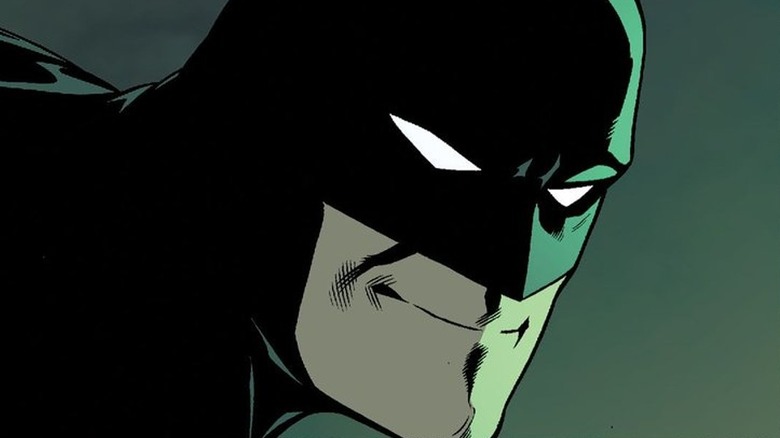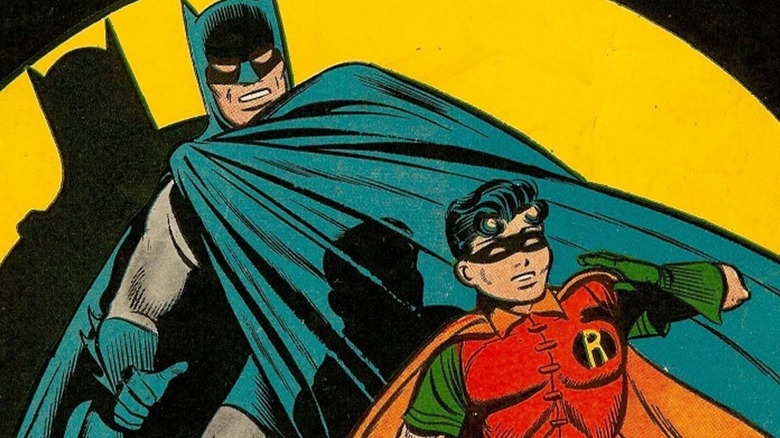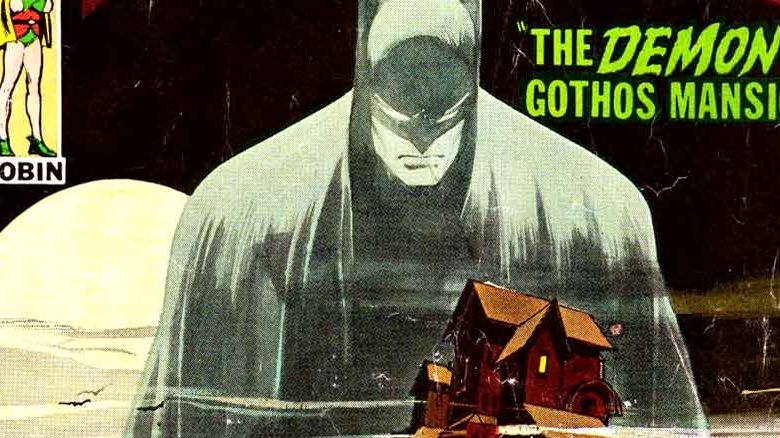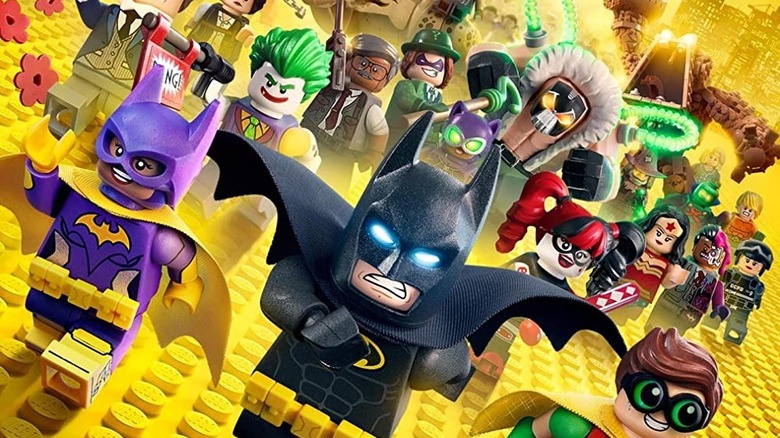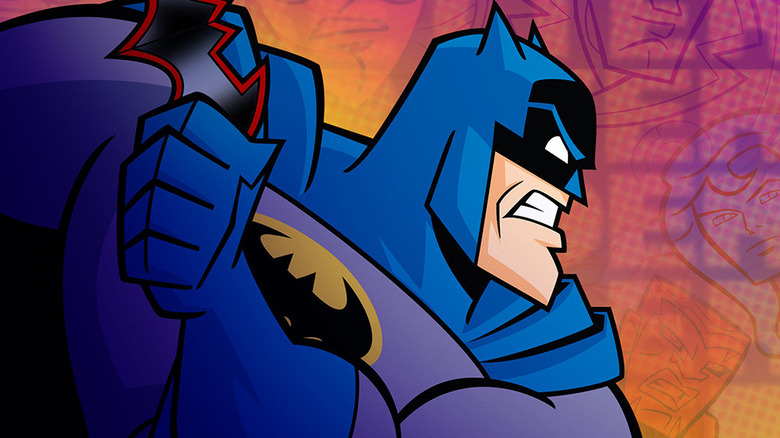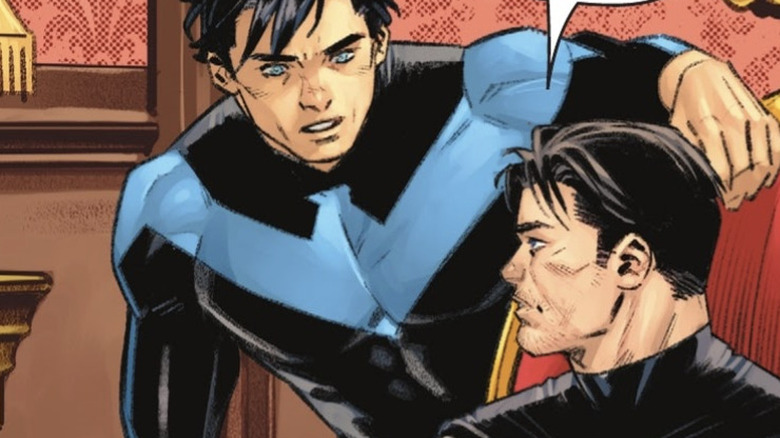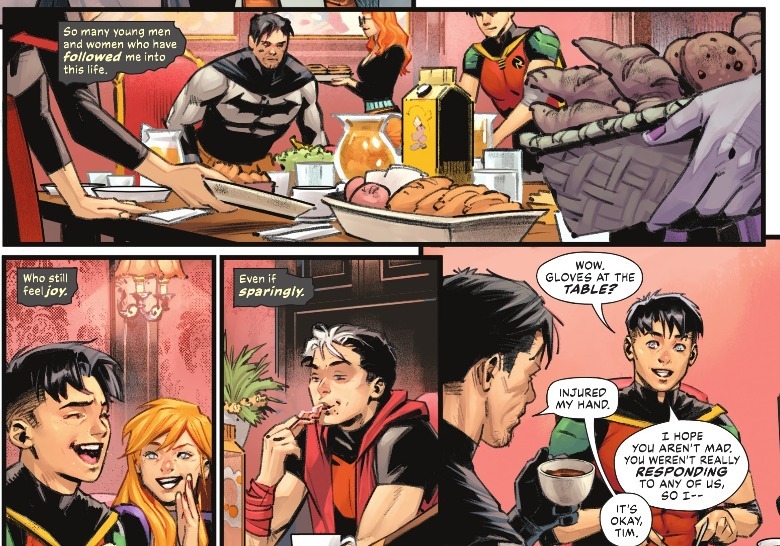Chip Zdarsky's Batman Comic Proves Why A Lighter Dark Knight Works
Contains spoilers for "Batman" #136.
Batman is one of the most popular characters in all of fiction, yet over the years, the Caped Crusader's stories have transitioned from lighter, fun romps to darker, more brooding tales of the Dark Knight. It seems rare these days — especially in the comics — for Batman to show off the less serious, more adventurous side that defined the hero in some of his earlier comics. But it doesn't have to be like that.
Yes, Batman is a direct, ultra-serious vigilante who constantly thinks and obsesses about his next move, is always trying to gain an advantage against his foes, and continually learns to improve himself. Bruce Wayne's grimness has often put him at direct odds with the Bat-Family, and even the people he's trying to protect. For a while, DC never seemed particularly interested in changing the status quo. However, in the newest issue, "Batman" #136 by Chip Zdarsky, Belen Ortega, Tomeu Morey, and Clayton Cowles, readers are reminded that every modern Batman story doesn't need to be dark — and Wayne deserves to have some levity in his life, despite the circumstances he's created for himself.
In the comic, Batman is portrayed enjoying a surprise breakfast with his family. He's allowed to relax and have fun, even with more urgent matters to eventually deal with. It's an interaction with the Bat-Family that is refreshing to see, and readers want more of. This paints an interesting portrait of a cultural shift occurring, where Batman doesn't always need to be dark — and allowing him to lighten up, at least sometimes, hearkens back to his past.
Batman wasn't always an ultra serious hero
First, let's dive into a history lesson. Because Batman's debut in "Detective Comics" #27 by Bob Kane and Bill Finger was, in certain ways, darker than most Batman stories today.
In that issue, Batman showed no resistance to killing, while patrolling Gotham City at night. From the late 1930s into the early 1940s, Batman's comics would be crime noir tales, with Batman preventing robberies, taking down villains, and saving the day. He wielded a gun and regularly broke his now-famous rule. Even when Robin joined Batman as his sidekick in 1940, his stories remained dark and dramatic. So, what changed? With the Comics Code Authority being introduced in the mid-1950s, comics began to self-regulate, to crack down on the portrayals of criminality, violence, horror, and sexual themes, among other contentious topics at the time. As a result, Batman and Robin's stories veered more into family-friendly territory.
Batman's comics became campier, with the hero facing off against more ridiculous threats than ever before, including several entanglements with aliens. In the mid-60s, Batman would take an even bigger dive into the deep end of his goofier side, with Adam West and Burt Ward's live-action "Batman" series becoming incredibly popular, leading to an extended push to make the Dark Knight's stories in the comics align closer with how he appeared on the iconic television show.
At the time, a dark Batman seemed as weird as a light Batman does today. However, Bruce Wayne would soon find himself back in his old dark headspace in the 1970s, thanks to legendary creators breathing new life into the classic hero.
Batman truly became the dark hero readers know today in the 1970s
The Batman we know today, arguably, came from the 1970 run of Dennis O'Neil and Neal Adams. Their moody work in "Detective Comics" would transform how audiences saw the hero forever, as they stripped Batman of his campiest elements, brought back the mystery and darkness of the original comics, revamped his look, and even introduced iconic new villains like Man-Bat and Ra's Al Ghul. Their work set the tone for all Batman stories of the future, directly influencing the version of the character seen in "Batman: The Animated Series" and inspiring Frank Miller and Alan Moore to craft even darker Batman stories in the 1980s.
However, after Batman got increasingly dark in that time period — most notably in Miller's "The Dark Knight Returns" — some creatives took the wrong lessons from this success. These days, Batman has hit a wall of extremes, where the character seemingly isn't allowed to have fun, needs to constantly be brooding, and must continually alienate his loved ones. This has extended to films like Matt Reeves's "The Batman," which — while a great movie — continues depriving the character of his more fun elements, such as sidekicks and goofy villains.
Batman's dark nature has become cliche at this point, making heartfelt and personal moments of growth and happiness all the rarer.
Batman has become something of a self-parody
Batman's darkness has gotten so extreme that, by now, he's a parody of himself, as seen by several projects which poke fun at the character's dark history in very self-aware ways. Throughout "The Lego Batman Movie," the pint-sized version of the hero constantly expresses how he doesn't feel anything emotionally besides rage and is constantly brooding throughout. BMeanwhile, "Teen Titans: Go To The Movies" pointed out how Batman's dark origin at Crime Valley has been seen so many times it's become less impactful — with a hilarious (and dark) scene involving Robin changing the future by intervening on Bruce Wayne's parents' deaths.
In the "Harley Quinn" animated series, Bruce Wayne's trauma is also played up for humor, referencing how films have continually exploited his personal tragedy. In the Season 3 episode, "There's No Ivy in Team," Batman directly calls out his portrayals, stating, "Haven't they exploited that poor, rich Wayne family enough? Every few years there's another film about depicting the Waynes' murder. We get it. Crime Alley. The pearls. Those pearls, their beautiful child watches them fall, as life is extinguished from his mother's eyes, so too is his innocence. It's one thing for Bruce Wayne to talk about his trauma, but for others to do it over and over again..."
When even Batman himself knows the truth behind his origin being repeated ad nauseum, it's a problem. DC Comics doesn't need to (and shouldn't) embrace full-blown humor within Batman's comics, but some self-reflection is needed. Real people aren't dark all the time. Batman shouldn't be, either.
Lighter Batman depictions are becoming more popular
Thankfully, with so much Batman media available (including what feels like five new Batman-focused comic titles out each week), there has been an increasing amount of room for the hero to show off his lighter side. This has led to some of the best modern Batman comics — such as Tom King and Clay Mann's "Double Date" story from "Batman" #137, and the entirety of Mark Waid, Dan Mora, and Tamra Bonvillain's "Batman/Superman: World's Finest" run, which highlights the friendship between the two pillars of the DC Universe. Additionally, there's stuff lik "Batman: Wayne Family Adventures," which feels like a much-needed palate cleanser as one of the more positive Batman-related stories. And on the animation side, "Batman: Brave and the Bold" offered a wide array of entertaining Batman stories that never took themselves too seriously, and may hopefully influence the upcoming DCU film of the same name.
Batman stories can still be dark, but this needs to be juxtaposed against happier moments for the hero. Seeing him constantly suffer is depressing. Just because he's the Dark Knight doesn't mean he can't have moments of jubilation. There's a fine line to toe between gritty 1970s Batman and the sillier side — something Zdarsky has done well in his short run on the Caped Crusader so far.
Batman is best when his family are allowed to flourish alongside him
Ultimately, seeing "Batman" hang out with the Bat-Family in "Batman" #136, alongside Cassandra Cain, Tim Drake, Spoiler, Jason Todd, and more of his former proteges, makes for a nice change of pace. These heroes have all suffered great tragedy, especially with the somewhat recent death of Alfred Pennyworth. So, to see them still able to enjoy each other's company is a welcome sight. It serves as a stark reminder that even when Batman is being put through the wringer, it's okay to bring him out of the darkness.
In fact, the lighter moments bring us closer to the characters, and allow us to feel deeper when things go wrong.
The surprise breakfast depicted in this newest issue also gives the spotlight to some heroes who deserve it. Readers have been wanting more interactions with Batman, Cain, and Spoiler, for example, since the conclusion of James Tynion IV's "Detective Comics" run. These earned moments have fallen to the wayside, amid Batman's darker storylines.
Batman works best when surrounded by his family. He's not the loner popular culture pretends he is. That doesn't mean stories can't be darker, but DC losing the plot when it comes to his human side has become unfortunately prevalent in modern stories, and thankfully, Zdarsky's run seems to be changing that mindset. A mopey, dark Batman has its place, but a happy Batman is also allowed, and it's time creatives embraced his past and present simultaneously, to make Batman more than just a reflection of his darkness. Truthfully, Batman's stories will be better because of it.
